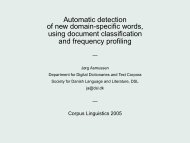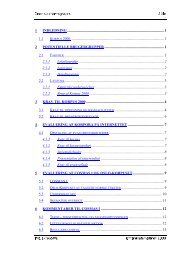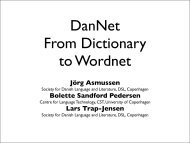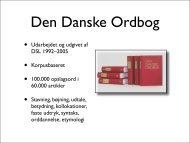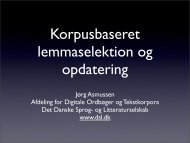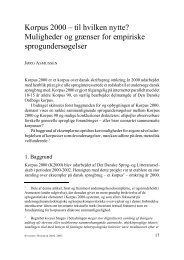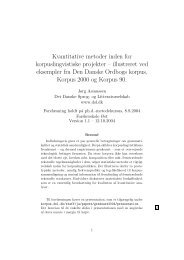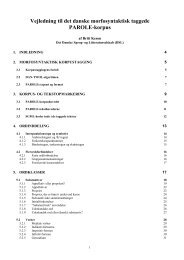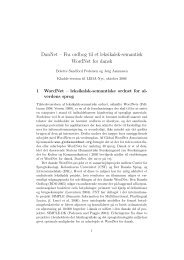The Corpus Thread - Det Danske Sprog- og Litteraturselskab
The Corpus Thread - Det Danske Sprog- og Litteraturselskab
The Corpus Thread - Det Danske Sprog- og Litteraturselskab
Create successful ePaper yourself
Turn your PDF publications into a flip-book with our unique Google optimized e-Paper software.
7.2. <strong>The</strong> ePOS tag set for Danish 142<br />
responding, unambiguous tag is assigned. Tags outside this strictly inflectional<br />
scope, e.g. on syntax, semantics, or morphol<strong>og</strong>ical composition of<br />
lemmas, are currently not provided.<br />
As the tagger is trained on the Danish PAROLE <strong>Corpus</strong>, the tag set of the<br />
ePOS tagger will be based on that one used by PAROLE (see Keson (1998a)<br />
and Keson (1998b)), however with some modifications, some of them as a<br />
consequence of the modified token concept, cf. Section 7.1.2, some of them<br />
for simplification reasons in order to hopefully achieve a better language<br />
model. <strong>The</strong> ePOS tagger utilizes a full-form lexicon that is compiled from<br />
the following three resources:<br />
⊲ An existing full-form lexicon derived from an earlier version of <strong>The</strong><br />
Danish Dictionary: FLEXIKON.<br />
⊲ <strong>The</strong> freely available FLEXION lexicon established by Ole Norling-<br />
Christensen and others. 4<br />
⊲ A supplementary lexicon derived from the tagged PAROLE material.<br />
<strong>The</strong> ePOS full-form lexicon is described more in-depth in Chapter 8.<br />
7.2.1 Tag structure<br />
<strong>The</strong> PAROLE tag set is positional which means that within a tag a certain inflectional<br />
marker is always found at a fixed position in a sequence of markers<br />
making up the tag. For example, in the case of nouns, the gender marker<br />
is always found at position 3, number at position 4, case at position 5, and<br />
definiteness at position 8. However, the positional system is dependent on<br />
the POS in question: In the case of verbs, which also may carry nominal<br />
inflectional markers, definiteness is still at position 8, but gender is at 4,<br />
number at 6, and case at 11. <strong>The</strong>se varying positions would make it very<br />
cumbersome later on to perform corpus queries of the type find all words<br />
that are marked for case = “genitive” no matter what their POS is. <strong>The</strong> ePOS<br />
tag set therefore favors fixed, POS-independent marker positions.<br />
In contrast to ePOS and PAROLE, the tag set applied by FLEXIKON and<br />
ONCLEX is a compact tag set that leaves out non-applicable and implicit<br />
information. Hence, it is easy to decode for humans, but may be difficult<br />
to formulate complex morphol<strong>og</strong>ical corpus queries on. <strong>The</strong>refore, the tag<br />
4<br />
Called ONCLEX in the following to better distinguish it from FLEXIKON. ONCLEX can<br />
be downloaded from:<br />
http://korpus.dsl.dk/e-resurser/boejningsformer_download.php?lang=en



